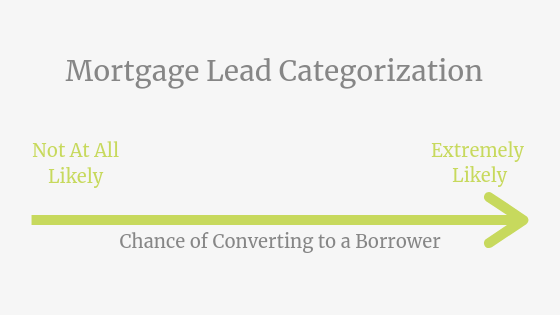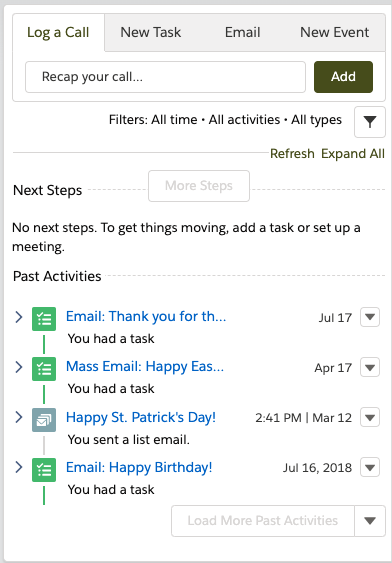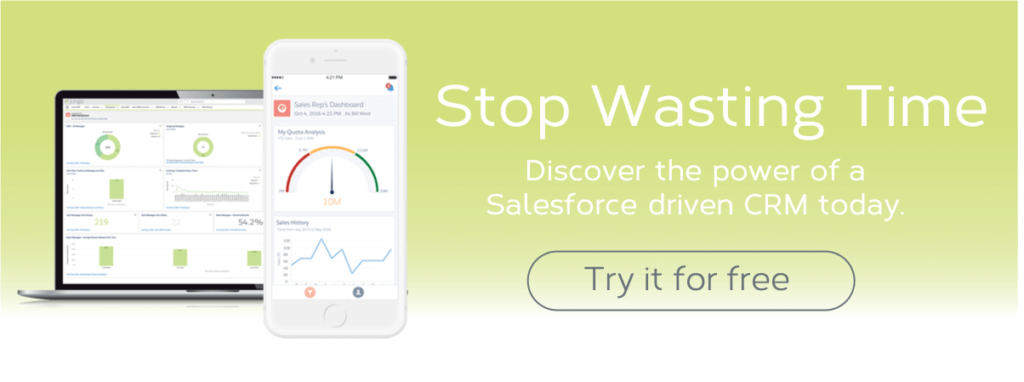

If you’ve been reading our most recent tips and tricks for loan officers, then you already have learned Everything You Need to Know About Getting Mortgage Leads. Plus, you’ve discovered some creative lead generation techniques in our post, How to Get More Mortgage Leads No Matter the Market. (catch up here, and here).
But, do you have a plan for converting mortgage leads into borrowers?
If your answer is “No,” or “I’m not sure,” then you’re missing out on an opportunity that you cannot afford to lose. Following up with leads is actually even more important than getting the leads in the first place.
After all, if you’re not dedicating the time and energy necessary to convert leads into borrowers, your loan volume is probably suffering. Don’t worry though! We have your step-by-step guide for following up with leads, so all you need to do is keep reading.
Gather Your Lead’s Contact Info
You may choose to buy leads, generate them organically, or utilize some combination of the two. However you get your leads, it’s important to have as much information about them as possible. Think beyond just their name and phone number.
Can you get their email address? How about their age or zip code? In some circumstances, you may even be able to brainstorm a few talking points before contacting them. If this lead came through a referral, you’ll have a better chance of having more personal data. Just be sure to ask the right questions when you receive the referral.
Database Your Leads
Don’t forget this often overlooked step! Even though your lead isn’t a borrower yet, you still should put them into your customer relationship management (CRM). Entering them into your database greatly simplifies the follow-up process, and also increases your chance for successful conversion.

If you’re shopping around for a CRM, consider looking for one that allows you to track calls, texts, and other touchpoints that you have with your contacts. Plus, a good CRM will allow you to easily transition a contact from lead, to borrower, to past customer. These status changes will trigger automated workflows, prompting you to follow-up exactly when you need to.
Categorize Your Leads
After you’ve gathered as much info about your lead as you can, you’re ready to make a determination about their likelihood to convert. This isn’t a guaranteed guess, so don’t worry if you’re not sure how to categorize leads, especially when you’re just beginning the process.
One way to think about leads is by trying to place them on a scale, ranging from “Not at All Likely to Convert” on the left, to “Extremely Likely to Convert” on the right. Chances are that none of your leads will fall on either extreme of this spectrum. But it can be helpful to have an idea of where they may be at in their process. Not only will this knowledge help you prioritize your leads list, it will also help you tailor your approach as you speak to them.

How Do You Categorize Your Leads?
Characteristics that may affect your estimate about a lead’s chances of converting can be wide ranging. For instance, if a lead submitted their data via an electronic form on your website, you may be able to gather data from the personal message they added. Maybe they mentioned that they are interested in refinancing since rates are lower than when they first got a mortgage.
Or, perhaps a past customer gave you a referral lead and mentioned to you that they are very anxious to move, since their lease will be up shortly. Both of these scenarios could be easily placed on the side of “Very Likely to Convert.” Therefore, you should focus a lot of care and time on connecting with them!
On the other hand, consider a paid lead you have received. You can see that the person submitted their name and email address through Zillow, but they indicated that they were “Just Looking,” and not serious about the house hunting process. Of course, you’ll still want to reach out to these mortgage leads, but knowing that they are less likely to convert will help you prioritize your schedule.
Make a Game Plan
Now that you know who you need to follow-up with, how are you going to approach them? Some loan officers like to call as soon as they get a lead’s information, which can be helpful. This method works because leads are more likely to convert the sooner they are called.
However, this isn’t the only way to approach nurturing a lead. You could choose to send an introductory email or even text, and then call soon after. When deciding how you would like to approach new leads, consider what has worked well for you in the past. Also consider the type of lead: after all, your strategy may change depending on if your lead was a referral, purchased, or found through online marketing.
Start With a Phone Call
When you do end up picking up the phone to call your newest lead, think ahead of time what you’d like to say. Here are a few things that you could consider putting into your initial phone call plan: a brief introduction, a few questions about their mortgage needs, and an invitation to contact you if they would like more information.
Don’t forget to include a brief heads-up at the end of your call that you will follow up with them shortly. Of course, thank them for their time! Making your leads feel valuable and cared about is key to a high conversion rate.
Put Them On a Dialer List
If the number of leads that you need to call every week is especially high, you could consider some helpful software options to increase efficiency. A phone dialer is a program that helps you set up call lists. They can sync with your CRM and even dial for you, so you no longer have to search for a number and dial manually. It may sound like a small savings, but cutting out 10 seconds per lead could save you hours over the course of a week.
Many times, having a call list for leads will actually “force” you to call them. So in addition to the time savings, you’ll actually call more leads because you won’t get distracted in between calls.
Mortgage Leads: Drop a Voicemail
Another option, is a voicemail drop program, which plays your pre-recorded voicemail message if the call goes unanswered. This will save you the time and effort of leaving the same voicemail over and over again. Plus, you can continue onto your next call while the other voicemail is still being left. Your customers will still feel cared for, since you will speak with them (live!) if they do answer.
Then, Try Again
Once you’ve made your initial touch, it’s time to enact your next step: another follow-up. It can be helpful to switch your method of communication, so you may decide to email or text the lead. Whatever you choose, don’t wait too long before making your second contact.
We would recommend planning to make the second connection within two to four days of the first for best results. When deciding how long to wait between contact attempts, think about how you’d like to be treated as a customer. It can be difficult to walk the fine line between being persistent and being annoying. With time and practice, you’ll learn the perfect happy medium.
And Again.
That’s right, again. One of the foundational principles of successful lead conversion is endurance. Exactly how many times you choose to contact a new lead is up to you. However, successfully converting a mortgage lead to a loan applicant will probably take longer than you think.
Salesforce says that it takes 6 to 8 touches to convert a lead! That’s not a small number, so don’t get discouraged if a potential customer says that they’re still not ready to move forward after phone call #2.
Always Keep Track of Your Interactions
As you contact a lead, it’s important to keep track of all your attempts to convert them. You could use a simple Excel sheet or even a Word document to track this activity. However, this is another area where a powerful CRM can really come in handy.
As soon as you get off the phone with a lead, or send an email or text to them, log the interaction! This is one of the best ways to earn customers. With this method of tracking touches, you can note when you spoke with them, and what your interaction consisted of. Then, next time you connect with them, you know exactly where you left off in your conversation.

Jungo’s Contact Interaction Tool
Why Is Tracking Customer Interaction a Good Idea?
Customers will appreciate the fact that you seem to instantly remember all the details from your last conversation. Plus, following these tracking guidelines within your CRM can also help you to remember to stick to your lead contact plan. Within a CRM like Jungo, as soon as you log a call, email, or text message, an automated workflow is triggered. This workflow can be customized to match your own best practices. Many top producers use it to send drip marketing campaigns.
It’s also a great idea to set your workflow to automatically update your to-do list with a task to reach out to your lead again. One less thing to remember (updating your tasks) means less follow through friction, and a higher chance you’ll end up sticking to your plan.
Stick To It
As difficult as it can be to implement a new business plan, the important thing isn’t just your strategy. Instead, the most critical thing is to stick to it. With this in mind, consistency is king.
You probably won’t see incredible ROI immediately, but don’t get discouraged. Continue to call, email, and text new leads. Keep logging your interactions. Find ways to offer value and advice to potential customers. Then, you’ll begin to see higher rates of conversion, and therefore, more loans in your pipeline.
Your plan will (and should!) change over time, so remain flexible in your methods. Pay attention to what works and what doesn’t in your plan for converting mortgage leads. You should also consider talking with your team and other loan officers to see what they would recommend you do.
If you continue to have low conversion rates, look into why that may be. For instance, why are your purchased mortgage leads not converting? Maybe you should consider organic lead generation. Or, ramp up your referral campaigns if you’d like to better leverage your current client base.
Bottom Line
How you choose to approach converting mortgage leads is completely up to you. Because the truth of the matter is, you didn’t become a top producing loan officer by being like everyone else! Customers will appreciate a unique and heartfelt approach to your communication plan. So, don’t be afraid to make your plan for mortgage leads your own.






